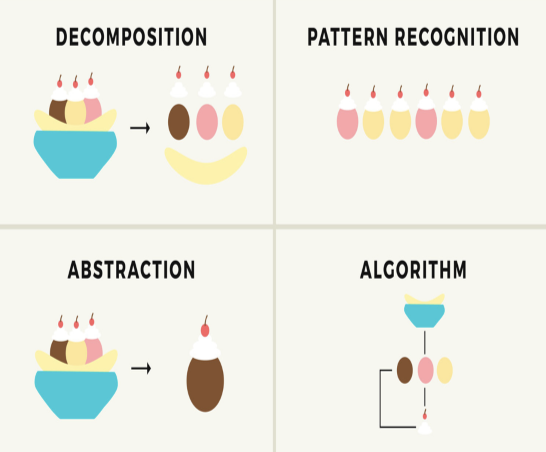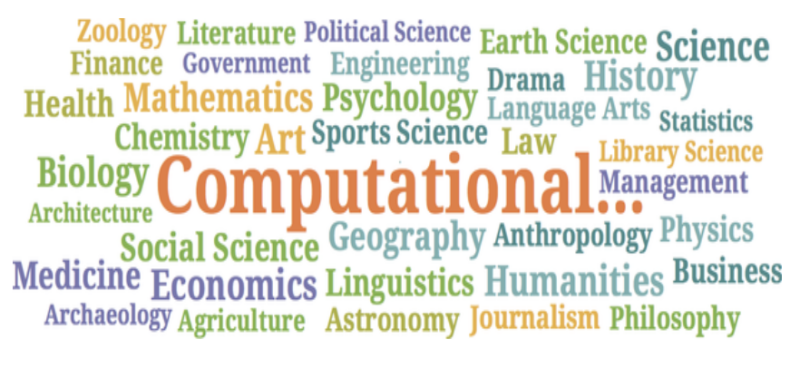You might recognize computational thinking as a trendy new buzzword. If you’re asking yourself “What is computational thinking?” or “I teach English—how am I supposed to incorporate it in my classroom?” you’re in the right place.
What is computational thinking?
Computational thinking is thinking and solving problems like a computer, or making your data easy for a computer to solve. This is not limited to math—anyone can use computational thinking. It’s about rearranging and reorganizing your thoughts and information logically. It can be used in things like coding and computer science, but you’re probably doing some of this in your daily instruction already.
Take a look at ISTE computational thinking standards.
What are the 4 pillars of computational thinking skills?
Source: Tiny Thinkers
Computational thinking (CT) consists of four pillars that guide our thinking and problem-solving: decomposition, pattern recognition, abstraction, and algorithms. We use each of these concepts every day. We can break down (or “decompose”) the pillars into smaller parts to learn more about them.
Decomposition
Decomposition means breaking a task or problem into smaller, manageable parts. We do this every day with things like cleaning the house, getting dressed, cooking a recipe, or building furniture. For example, when you clean your house, you don’t start by cleaning the whole house at once. You simplify your tasks: putting the dishes away, putting laundry away, cleaning the bathroom, and cleaning the floors.
Undoubtedly you already do this for your students. Let’s say you’re teaching your students how to write an essay for the first time. Likely, you deconstruct the essay into smaller parts and teach them separately before putting it all together. You might teach your students how to write a topic sentence, how to organize an opening paragraph, how to use supporting details, how to write a conclusion, and how they can reread their work for clarity before they try a full essay on their own.
Pattern Recognition
Pattern recognition is precisely what it sounds like: recognizing patterns. We do this from kindergarten through 12th grade in all subjects, and in our own lives too. To create steps to solve a problem, we first have to recognize the patterns that can help us solve it.
The Common Core mathematical standards require pattern recognition, so math teachers automatically have this covered. But elementary teachers live and breathe patterns with their instruction. They read books containing patterns, create patterns with blocks, play games like Duck-Duck-Goose, and they may even organize their calendars with patterned pieces.
Secondary teachers, you teach patterns too. World language instructors help students identify patterns when teaching conjugations, and science teachers may or may not break into song about the patterns on the periodic table.
Abstraction
Abstraction is the ability to cut through information to figure out what you genuinely need. You need to identify the crucial parts while tossing the fluff. This is a difficult skill to teach, but it’s necessary for CT (and honestly, for life—wouldn’t it be a dream to go to Target and come home with only the things you needed?). If we can’t remove the noise from our data, we won’t know what we need to solve our problem.
Everyone, even Latin teachers, helps their students weed out unimportant details. In Latin, we derive meaning from the declensions of words (or the endings attached to words—which happen to follow patterns). In this case, we teach students to make meaning by focusing on the endings of words rather than the order of words since the words can go anywhere in a sentence.
Algorithms
Algorithms are not just for math teachers. We all use algorithms all the time. (And now that you know that, you can sound as fancy as a math teacher when you talk about your “attire algorithm,” aka your procedure for getting dressed.) Algorithms are detailed, step-by-step instructions that you use to solve a problem. When we solve problems with CT, we want to create algorithms to help us solve them while achieving consistent results.
Returning to our “attire algorithm,” we really do use one to get dressed, and it matters. While certain steps might vary from person to person, we all employ the same ideas when we get dressed. We put on underwear before pants and tops, and we put blouses and shirts on before we put on jackets. If it’s cold, we wear long sleeves and sweatshirts or sweaters. If it’s raining, we add rain boots.
Read more about the four pillars.
Why is computational thinking important in education?
Computational thinking is beneficial to anyone seeking a STEM career, especially one based in computer science or technology. But CT is also beneficial in every subject and career. It develops time-management and task-planning skills, essential components of executive functioning. It also teaches us how to give work to others when a project is too big for one person. Because it forces us to think like a computer, it instills analytical and logical reasoning too. Since it’s a way of thinking and not a specific discipline, everyone can use CT. As we integrate technology into all jobs, it’s important to make sure we can complete our work in a technologically compatible way.
Read more about the benefits of CT.
Where is computational thinking used?
Source: Stephen Wolfram
Since computational thinking is thinking in a way that’s compatible with computers and an approach to logical problem-solving, it can be used in every subject, not just STEM. CT is all hands on deck in all grade levels. The good news is that since CT is more of a lifestyle than a subject, you can integrate it into things you are already doing with some tweaks. (Or you may have been doing this for years, in which case you can say, “I was teaching computational thinking before it was cool.”)
How can I teach computational thinking today?
Interested in trying out computational thinking? You can start today. There are endless strategies for teaching computational thinking. Sphero and Teach Your Kids Code offer some easy ways to start teaching CT for which you can easily throw together the materials needed.
Decomposition
One of the best (and probably one of the most hilarious) ways to teach decomposition is to pick a basic task and let your students teach you how to do it. Follow their directions literally. Be aggressively literal when you complete the steps. It can be anything from unpacking a bag to making a sandwich to washing a dish. Your class will quickly be able to identify the tiny steps they missed the first time that are necessary to complete the bigger task.
Pattern Recognition
You can do any type of sort, and you’ve taught pattern recognition.
- Spelling sorts based on rules such as vowel-consonant-e or short vowel patterns
- Sort vocabulary words in science or social studies. Provide a word bank and have students sort them by concept or meaning.
Whatever sorting activity you do, have students discuss and explain their reasons for their groupings.
Abstraction
If you need to teach your class how to weed out nonsense quickly, give them a word count assignment. You don’t even need to plan for this one. Assign a writing task as usual, but give them a word count. The students will have to filter out the unimportant details to keep their word count under the limit. You can slide the limit down as they get better at this.
The House lesson, from Cris Tovani’s I Read It, But I Don’t Get It, asks students to find key information based on varying purposes. They have to identify generally important information, then identify information that would be important to a burglar, and finally, identify information that would be of interest to a realtor.
Algorithms
Sphero suggests the age-old peanut butter and jelly sandwich lesson to teach algorithm creation. (You may have to switch to SunButter for your peanut-allergic students). Have your students create recipes to make a PB&J sandwich and then swap with their neighbors. Then they have to make the sandwich from their peers’ recipes. Grab some popcorn as chaos ensues. But shortly afterward, you’ll find your students writing increasingly more detailed steps to get the consistent outcomes they want.
Ready for a challenge? Learn to solve a Rubik’s Cube with your class.
See other examples of CT strategies in action.
Resources and Tools for Developing Computational Thinking
If you are looking for even more ways to use computational thinking in your classroom, check out these resources.
Equip Learning shares some lesson plans by grade level for developing computational thinking.
These coding apps let students practice writing step-by-step directions.
CT Lessons offers lesson plans by subject and grade for many disciplines.
Have more questions about computational thinking and how to teach it to your students? Join the WeAreTeachers HELPLINE group on Facebook to exchange ideas and ask for advice!
Plus, check out our list of critical thinking questions.



